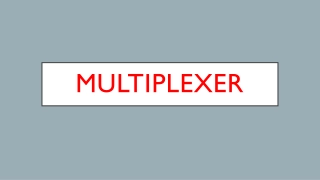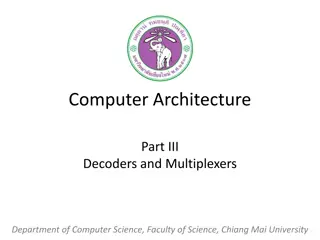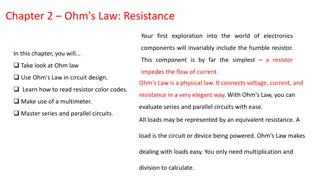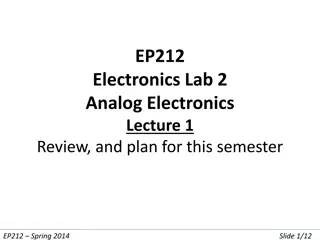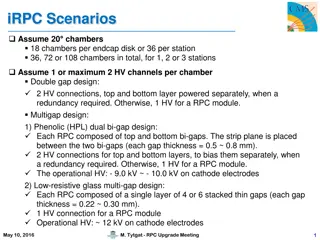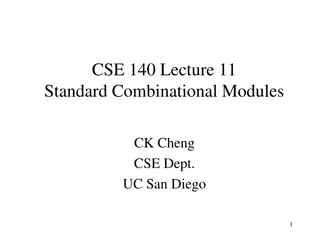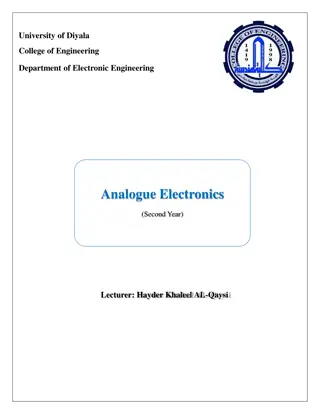Understanding Multiplexers in Electronics
A multiplexer, or mux, is a key component in electronics that selects and directs binary information from multiple input lines to a single output line. It functions as a data selector, enabling the efficient flow of information in electronic circuits. This article explores the working principle, applications, and examples of 2-to-1 and 4-to-1 line multiplexers, shedding light on their importance in modern electronic systems.
Download Presentation

Please find below an Image/Link to download the presentation.
The content on the website is provided AS IS for your information and personal use only. It may not be sold, licensed, or shared on other websites without obtaining consent from the author. Download presentation by click this link. If you encounter any issues during the download, it is possible that the publisher has removed the file from their server.
E N D
Presentation Transcript
MULTIPLEXERS MULTIPLEXERS
MULTIPLEXERS MULTIPLEXERS A multiplexer is a combinational circuit that selects binary information from one of many input lines and directs it to a single output line. The selection of a particular input line is controlled by a set of selection lines. Normally, there are 2ninput lines and n selection lines whose bit combinations determine which input is selected.
MULTIPLEXERS MULTIPLEXERS A multiplexer is also called a data selector , since it selects one of many inputs and steers the binary information to the output line. The size of a multiplexer is specified by the number 2nof its data input lines and the single output line. The n selection lines are implied from the 2ndata lines
Applications In electronics, a multiplexer or mux is a device that selects one of several analog or digital input signals and forwards the selected input into a single line. An electronic multiplexer can be considered as a multiple-input, single-output switch i.e. digitally controlled multi-position switch. The digital code applied at the select inputs determines which data inputs will be switched to output. A common example of multiplexing or sharing occurs when several peripheral devices share a single transmission line or bus to communicate with computer. Each device in succession is allocated a brief time to send and receive data. At any given time, one and only one device is using the line. This is an example of time multiplexing since each device is given a specific time interval to use the line. In frequency multiplexing, several devices share a common line by transmitting at different frequencies.
2-to-1 line Multiplexer A two-to-one-line multiplexer connects one of two 1-bit sources to a common destination, The circuit has two data input lines, one output line, and one selection line S . Y S 0 I0 I1 1
2-to-1 line Multiplexer When S = 0, the upper AND gate is enabled and I0has a path to the output. When S = 1, the lower AND gate is enabled and I1 has a path to the output. The multiplexer acts like an electronic switch that selects one of two sources
4-to-1 line Multiplexer A four-to-one-line multiplexer has four inputs, I0 through I3, each input is applied to one input of an AND gate. Selection lines S1 and S0 are decoded to select a particular AND gate. The outputs of the AND gates are applied to a single OR gate that provides the one-line output.
To demonstrate the operation of the circuit, consider the case when S1S0 = 10. The AND gate associated with input I2 has two of its inputs equal to 1 and the third input connected to I2. The other three AND gates have at least one input equal to 0, which makes their outputs equal to 0. The output of the OR gate is now equal to the value of I2, providing a path from the selected input to the output.
Quadruple 2-to-1-line Multiplexer circuits can be combined with common selection inputs to provide multiple-bit selection logic A quadruple 2-to-1-line multiplexer circuit has four multiplexers, each capable of selecting one of two input lines. Input selection line S selects one of the lines in each of the four multiplexers. The enable input E must be active (i.e., asserted) for normal operation. Although the circuit contains four 2-to-1-line multiplexers, we are more likely to view it as a circuit that selects one of two 4-bit sets of data lines
Decoder as MUX As in decoders, multiplexers may have an enable input to control the operation of the unit. When the enable input is in the inactive state, the outputs are disabled, and when it is in the active state, the circuit functions as a normal multiplexer. 4-to-1 line Multiplexer using Decoder
Boolean Function Implementation Boolean Function Implementation A decoder can be used to implement Boolean functions by employing external OR gates. An examination of the logic diagram of a multiplexer reveals that it is essentially a decoder that includes the OR gate within the unit. The minterms of a function are generated in a multiplexer by the circuit associated with the selection inputs. The individual minterms can be selected by the data inputs, thereby providing a method of implementing a Boolean function of n variables with a multiplexer that has n selection inputs and 2n data inputs, one for each minterm.
Boolean Function Implementation Boolean Function Implementation consider the Boolean function F (x, y, z) = (1, 2, 6, 7) This function of three variables can be implemented with a 4-to- 1-line multiplexer. The two variables x and y are applied to the selection lines in that order; x is connected to the S1 input and y to the S0 input. The values for the data input lines are determined from the truth table of the function
implementation of the Boolean function F (A, B, C, D) = (1, 3, 4, 11, 12, 13, 14, 15)
Demultiplexer Demultiplexer A demultiplexer (or demux) is a device taking a single input signal and selecting one of many data-output-lines, which is connected to the single input. A multiplexer is often used with a complementary demultiplexer on the receiving end. A demultiplexer is a single-input, multiple-output switch. Demultiplexers take one data input and a number of selection inputs, and they have several outputs. They forward the data input to one of the outputs depending on the values of the selection inputs. Demultiplexers are sometimes convenient for designing general purpose logic, because if the demultiplexer's input is always true, the demultiplexer acts as a decoder. This means that any function of the selection bits can be constructed by logically OR-ing the correct set of outputs. Demultiplexer is called as a distributro , since it transmits the same data to different destinations.
1-to-4 DEMUX Truth table, block diagram, logic circuit design
Three Three- -State Gates State Gates A multiplexer can be constructed with three-state gates digital circuits that exhibit three states. Two of the states are signals equivalent to logic 1 and logic 0 as in a conventional gate. The third state is a high-impedance state in which (1) the logic behaves like an open circuit, which means that the output appears to be disconnected, (2) the circuit has no logic significance, and (3) the circuit connected to the output of the three-state gate is not affected by the inputs to the gate. The high-impedance state of a three-state gate provides a special feature not available in other gates. Because of this feature, a large number of three-state gate outputs can be connected with wires to form a common line without endangering loading effects.
Three Three- -State Gates State Gates Three-state gates may perform any conventional logic, such as AND or NAND. However, the one most commonly used is the buffer gate. It is distinguished from a normal buffer by an input control line entering the bottom of the symbol. The buffer has a normal input, an output, and a control input that determines the state of the output. When the control input is equal to 1, the output is enabled and the gate behaves like a conventional buffer, with the output equal to the normal input. When the control input is 0, the output is disabled and the gate goes to a high-impedance state, regardless of the value in the normal input.
Three Three- -State Gates State Gates 2-to-1 line MUX with three state gates Three state buffer


